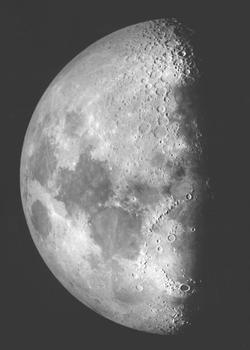GRAIL Mission To Determine What Makes The Moon Tick
 At a Monday meeting of the American
Geophysical Union, NASA's Associate Administrator for Science Alan
Stern announced the selection of a new mission that will peer deep
inside the moon to reveal its anatomy and history.
At a Monday meeting of the American
Geophysical Union, NASA's Associate Administrator for Science Alan
Stern announced the selection of a new mission that will peer deep
inside the moon to reveal its anatomy and history.
The Gravity Recovery and Interior Laboratory, or GRAIL, mission
is a part of NASA's Discovery Program. It will cost $375 million
and is scheduled to launch in 2011. GRAIL will fly twin spacecraft
in tandem orbits around the moon for several months to measure its
gravity field in unprecedented detail. The mission also will answer
longstanding questions about Earth's moon and provide scientists a
better understanding of how Earth and other rocky planets in the
solar system formed.
"GRAIL's revolutionary capabilities stood out in this Discovery
mission competition owing to its unsurpassed combination of high
scientific value and low technical and programmatic risk," Stern
said. "GRAIL also offers to bring innovative Earth studies
techniques to the moon as a precursor to their possible later use
at Mars and other planets."
Scientists will use the gravity field information from the two
satellites to X-ray the moon from crust to core to reveal the
moon's subsurface structures and, indirectly, its thermal
history.
The study technique GRAIL will use was pioneered by the joint
US-German Earth observing Gravity Recovery and Climate Experiment,
or GRACE, mission launched in 2002. The GRACE satellites measure
gravity changes related to the movement of mass within the Earth,
such as the melting of ice at the poles and changes in ocean
circulation. As with GRACE, both GRAIL spacecraft will be launched
on a single launch vehicle.
GRAIL's principal investigator is Maria Zuber of the
Massachusetts Institute of Technology. Zuber's team of expert
scientists and engineers includes former NASA astronaut Sally Ride,
who will lead the mission's public outreach efforts. A camera
aboard each spacecraft will allow students and the public to
interact with observations from the satellites. Each GRAIL
spacecraft will carry the cameras to documents their views from
lunar orbits.
GRAIL will support NASA's exploration goals as the agency
returns humans to the moon by 2020. In 2008, the agency will launch
the Lunar Reconnaissance Orbiter, or LRO, to circle the moon for at
least a year and take measurements to identify future robotic and
human landing sites. The orbiter also will look for potential lunar
resources and document aspects of the lunar radiation environment.
After a 30-year hiatus, LRO represents NASA's first step toward
returning humans to the moon. The orbiter will be accompanied by
another spacecraft, called the Lunar Crater Observation and Sensing
Satellite mission, which will impact the lunar south pole to search
for evidence of polar water frost.
"As NASA moves forward with exploration endeavors, our lunar
science missions will be the light buoy leading the path for future
human activities," said Jim Green, director of the Planetary
Division, Science Mission Directorate, Washington.
Created in 1992, NASA's Discovery Program sponsors a series of
scientist-led, cost-capped solar system exploration missions with
highly focused scientific goals. The GRAIL proposal was selected
from 24 submissions in response to a 2006 Announcement of
Opportunity for the program. Proposals were evaluated for
scientific merit, science implementation merit, and technical,
management and cost feasibility.
NASA's Jet Propulsion Laboratory in Pasadena, CA will manage the
GRAIL mission. The spacecraft will be built by Lockheed Martin
Space Systems, Denver.
 ANN's Daily Aero-Term (04.26.24): DETRESFA (Distress Phrase)
ANN's Daily Aero-Term (04.26.24): DETRESFA (Distress Phrase) ANN's Daily Aero-Linx (04.26.24)
ANN's Daily Aero-Linx (04.26.24) Airborne 04.22.24: Rotor X Worsens, Airport Fees 4 FNB?, USMC Drone Pilot
Airborne 04.22.24: Rotor X Worsens, Airport Fees 4 FNB?, USMC Drone Pilot Airborne 04.24.24: INTEGRAL E, Elixir USA, M700 RVSM
Airborne 04.24.24: INTEGRAL E, Elixir USA, M700 RVSM Airborne-NextGen 04.23.24: UAVOS UVH 170, magni650 Engine, World eVTOL Directory
Airborne-NextGen 04.23.24: UAVOS UVH 170, magni650 Engine, World eVTOL Directory



